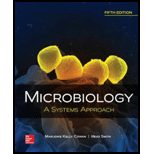
Microbiology: A Systems Approach
5th Edition
ISBN: 9781259706615
Author: Marjorie Kelly Cowan Professor
Publisher: McGraw-Hill Education
expand_more
expand_more
format_list_bulleted
Question
Chapter 14, Problem 13TF
Summary Introduction
Introduction:
The immune system is a network of cells, tissues, and organs that protects the body from infection and disease. It has three lines of defense system against pathogens- first, second and third line of defense system.
Expert Solution & Answer
Want to see the full answer?
Check out a sample textbook solution
Students have asked these similar questions
How do I determine the inhertiance pattern from the pedigree diagram?
its an open book assignemnt
Describe two different gene regulation mechanisms involving methylation
Chapter 14 Solutions
Microbiology: A Systems Approach
Ch. 14.1 - Summarize the three lines of host defenses.Ch. 14.1 - Identify two components of the first line of...Ch. 14.1 - Discuss the role of normal biota as a first-line...Ch. 14.2 - Define marker, and discuss its importance in the...Ch. 14.3 - Prob. 5AYPCh. 14.3 - List the components of the mononuclear phagocyte...Ch. 14.3 - Prob. 7AYPCh. 14.3 - Prob. 8AYPCh. 14.3 - Name six types of blood cells that function in...Ch. 14.3 - Prob. 10AYP
Ch. 14.4 - List the four major categories of nonspecific...Ch. 14.4 - Summarize the steps in phagocytosis, and describe...Ch. 14.4 - Outline the steps in inflammation.Ch. 14.4 - Discuss the mechanism of fever and its role in...Ch. 14.4 - Compare and contrast the three different...Ch. 14.4 - Name three types of antimicrobial proteins.Ch. 14 - Ail example of a nonspecific chemical barrier to...Ch. 14 - Which nonspecific host defense is associated with...Ch. 14 - Prob. 3MCQCh. 14 - Which of the following is not a lymphoid tissue?...Ch. 14 - Prob. 5MCQCh. 14 - Prob. 6MCQCh. 14 - Prob. 7MCQCh. 14 - Prob. 8MCQCh. 14 - Which of the following substances is/are not...Ch. 14 - Which of the following is the end product of the...Ch. 14 - The liquid component of clotted blood is called...Ch. 14 - Prob. 12TFCh. 14 - Prob. 13TFCh. 14 - Prob. 14TFCh. 14 - Prob. 15TFCh. 14 - Prob. 1CTQCh. 14 - Prob. 2CTQCh. 14 - Prob. 3CTQCh. 14 - a. Inflammation is characterized by heat, pain,...Ch. 14 - HIV predominantly infects T helper cells, cells...Ch. 14 - Prob. 1VCCh. 14 - Prob. 1CM
Knowledge Booster
Similar questions
- What is behavioral adaptarrow_forward22. Which of the following mutant proteins is expected to have a dominant negative effect when over- expressed in normal cells? a. mutant PI3-kinase that lacks the SH2 domain but retains the kinase function b. mutant Grb2 protein that cannot bind to RTK c. mutant RTK that lacks the extracellular domain d. mutant PDK that has the PH domain but lost the kinase function e. all of the abovearrow_forwardWhat is the label ?arrow_forward
- Can you described the image? Can you explain the question as well their answer and how to get to an answer to an problem like this?arrow_forwardglg 112 mid unit assignment Identifying melting processesarrow_forwardGive only the mode of inheritance consistent with all three pedigrees and only two reasons that support this, nothing more, (it shouldn't take too long)arrow_forward
- Oarrow_forwardDescribe the principle of homeostasis.arrow_forwardExplain how the hormones of the glands listed below travel around the body to target organs and tissues : Pituitary gland Hypothalamus Thyroid Parathyroid Adrenal Pineal Pancreas(islets of langerhans) Gonads (testes and ovaries) Placentaarrow_forward
- What are the functions of the hormones produced in the glands listed below: Pituitary gland Hypothalamus Thyroid Parathyroid Adrenal Pineal Pancreas(islets of langerhans) Gonads (testes and ovaries) Placentaarrow_forwardDescribe the hormones produced in the glands listed below: Pituitary gland Hypothalamus Thyroid Parathyroid Adrenal Pineal Pancreas(islets of langerhans) Gonads (testes and ovaries) Placentaarrow_forwardPlease help me calculate drug dosage from the following information: Patient weight: 35 pounds, so 15.9 kilograms (got this by dividing 35 pounds by 2.2 kilograms) Drug dose: 0.05mg/kg Drug concentration: 2mg/mLarrow_forward
arrow_back_ios
SEE MORE QUESTIONS
arrow_forward_ios
Recommended textbooks for you
 Medical Terminology for Health Professions, Spira...Health & NutritionISBN:9781305634350Author:Ann Ehrlich, Carol L. Schroeder, Laura Ehrlich, Katrina A. SchroederPublisher:Cengage LearningEssentials of Pharmacology for Health ProfessionsNursingISBN:9781305441620Author:WOODROWPublisher:Cengage
Medical Terminology for Health Professions, Spira...Health & NutritionISBN:9781305634350Author:Ann Ehrlich, Carol L. Schroeder, Laura Ehrlich, Katrina A. SchroederPublisher:Cengage LearningEssentials of Pharmacology for Health ProfessionsNursingISBN:9781305441620Author:WOODROWPublisher:Cengage Human Biology (MindTap Course List)BiologyISBN:9781305112100Author:Cecie Starr, Beverly McMillanPublisher:Cengage Learning
Human Biology (MindTap Course List)BiologyISBN:9781305112100Author:Cecie Starr, Beverly McMillanPublisher:Cengage Learning Human Physiology: From Cells to Systems (MindTap ...BiologyISBN:9781285866932Author:Lauralee SherwoodPublisher:Cengage Learning
Human Physiology: From Cells to Systems (MindTap ...BiologyISBN:9781285866932Author:Lauralee SherwoodPublisher:Cengage Learning

Medical Terminology for Health Professions, Spira...
Health & Nutrition
ISBN:9781305634350
Author:Ann Ehrlich, Carol L. Schroeder, Laura Ehrlich, Katrina A. Schroeder
Publisher:Cengage Learning

Essentials of Pharmacology for Health Professions
Nursing
ISBN:9781305441620
Author:WOODROW
Publisher:Cengage

Human Biology (MindTap Course List)
Biology
ISBN:9781305112100
Author:Cecie Starr, Beverly McMillan
Publisher:Cengage Learning


Human Physiology: From Cells to Systems (MindTap ...
Biology
ISBN:9781285866932
Author:Lauralee Sherwood
Publisher:Cengage Learning
